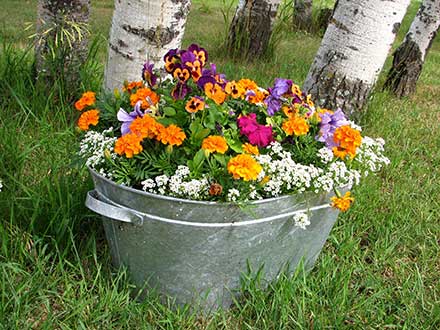
Container gardening has many possibilities. They vary from hanging baskets to larger planters. Wood, plastic, cement, ceramic are some of the materials suitable for containers. It needs to complement the plants in an aesthetic and functional way. For example, if you decide to grow strawberries, consider using a terra-cotta planter with special holes where you can cultivate the fruit. When using wooden troughs or baskets, make sure the wood is of high quality and is resistant to rot.
Fill the containers with a soil-less mix, such as potting soil, which retains the water, nutrients, and oxygen needed for plant growth. These mixes are not composed of real soil but various combinations of vermiculite and peat moss along with either perlite or ground pine bark to improve drainage and aeration. Apply a fertilizer, such as 10-10-10, 5-10-15, 5-10-10 or 6-12-12 or another one with a similar ratio. Mix all of these materials thoroughly to ensure that they are blended together evenly. Improper mixing can cause uneven distribution of the amendments that can interfere with root growth.
Container plants dry out faster and require more applications of water than those growing in the ground. Periodically feel the soil to determine if it needs water. If the soil is dry, then apply water until it trickles out of the holes at the bottom. Make sure the soil stays evenly moist. Mulching and windbreaks can help reduce water loss. The container plants should be sheltered from the sun during periods of intense summer heat to help retain moisture. The containers need to have adequate drainage. If the container has poor drainage, the roots will be more susceptible to root rot.
A variety of plants can be grown in containers such as small fruits, vegetables, herbs and ornamental plants. They can be mixed and grown together. Annuals, such as marigolds and begonias, provide color to any setting. Petunias thrive in a variety of containers and are great for hanging baskets. Zinnias perform well in intense heat. Perennials, such as coreopsis and hostas, are well suited for containers. Both annual and perennials require occasional fertilization and pruning. Bulbs, such as tulips, daffodils, and hyacinths should be planted in the fall and will bloom in the spring. They need to be kept watered, even during the cold weather months. Cacti and ferns also are suited for container gardening as well as houseplants.
A multitude of vegetables are suitable for containers. Those that require minimal space are the best. Tomatoes, peppers, beans, radishes, and most herbs thrive in containers. The taller vegetables need to be planted in larger containers and should be staked.
With a little creativity, container gardening can be an enjoyable way to grow plants. If given proper care, they can be attractive features in the home landscape throughout the growing season.
Timothy Daly, is an Agricultural and Natural Resource Agent with Gwinnett County Extension. He can be contacted at 678-377-4010 or timothy.daly@gwinnettcounty.com.

